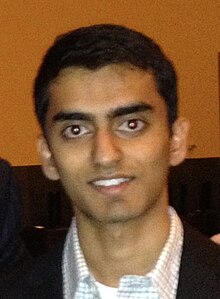Muthu Alagappan
Muthu Alagappan | |
|---|---|
 Muthu Alagappan at the 2012 MIT Sloan Sports Analytics Conference | |
| Born | 1989 or 1990 (age 33–34) |
| Occupation | Resident Physician |
| Known for | Basketball Statistical Analysis |
Muthu Alagappan (born c. 1990
Early life
Alagappan was born in
Basketball analytics
Alagappan was hired as an
He started with a collection of seven basic statistics (
The method is intended to change existing basketball team composition paradigms to help NBA teams win championships.
His data-driven analysis has been well received. He won the top prize in the "Evolution of Sports" category at the 2012
Rob Mahoney of The New York Times called the model "a novel execution of a productive thought", but cited the "one-of-a-kind" catch-all position and the substantial number of players categorized within it as weak points.[8] ESPN TrueHoop's Jim Calvan criticized Alagappan's Sloan conference presentation for its lack of data showing how team reconfiguration to cover the 13 positions results in more wins.[11]
References
- ^ MediaNews Group. Archivedfrom the original on 3 June 2013. Retrieved 3 June 2013.
- ^ a b c d e Van Riper, Tom (17 December 2012). "30 Under 30: Sports". Forbes. Archived from the original on 2 June 2013. Retrieved 3 June 2013.
- ^ Thambithurai, Nive (21 January 2013). "One of the 20 000: How an Engineering Student Became a Sports Analyst". Tamil Culture. Archived from the original on 6 June 2013. Retrieved 6 June 2013.
I was born in England, in Crewe, a city right near Manchester. I only lived there for a couple years because my dad, like many physicians, did his medical training in India, went to England to do some residency and more training, and used that as a way to come to America. Since then, I've lived in Galveston and Houston.
- ^ Condé Nast. Archivedfrom the original on 18 June 2012. Retrieved 6 June 2013.
- ^ "TEDx Spokane, Theme: Creativity, Action and Service, Spokane, WA, United States, March 16th, 2013". TED. Archived from the original on 4 June 2013. Retrieved 6 June 2013.
- ^ Don’t despair in the face of failure, biochemist tells grads
- ^ "Profile". NEJM Resident 360. Retrieved 19 January 2018.
- ^ a b c Mahoney, Rob (6 March 2013). "Trading 'Small Forward' for 'Scoring Rebounder'". The New York Times. Archived from the original on 27 May 2012. Retrieved 6 June 2013.
- Condé Nast. Archivedfrom the original on 19 October 2012. Retrieved 6 June 2013.
- ^ Van Riper, Tom; Morrell, Alex. "30 Under 30 - Sports". Forbes. Archived from the original on 19 June 2014. Retrieved 26 June 2014.
- ^ Calvan, Jim (9 March 2012). "Solving for W". TrueHoop. ESPN. Archived from the original on 15 May 2013. Retrieved 6 June 2013.
External links
![]() Media related to Muthu Alagappan at Wikimedia Commons
Media related to Muthu Alagappan at Wikimedia Commons
